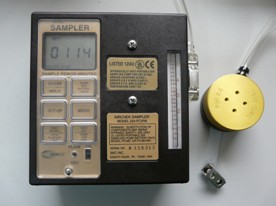Excess Heavy Metal in Beijing PM 2.5
china.org.cn / chinagate.cn by Jiao Meng, April 25, 2013 Adjust font size:
Heavy metal concentration detection and analysis of both air and individual samples in Beijing show that the concentration of arsenic in PM 2.5 is above the norm, according to a report jointly issued by Greenpeace and the Public Health Faculty of Peking University on Tuesday.
The report entitled "The Detection and Research on the Heavy Metal Concentration of PM 2.5 in Beijing", invited nine volunteers to carry individual sampler of PM 2.5 as to monitor metal contents from December 3, 2012 through to January 18, 2013, when Beijing experienced the most serious air pollution episode since PM 2.5 monitoring data first became available.
| Individual sampler of PM 2.5 |
|
Professor Pan Xiaochuan from the School Of Public Health, Peking University, explains the research results from the report entitled "The Detection and Research on the Heavy Metal Concentration of PM 2.5 in Beijing", on Tuesday in Beijing. [CnDG by Jiao Meng] |
Professor Pan Xiaochuan from the School Of Public Health, Peking University, believes that modern Chinese who live in the larger cities usually spend over 80 percent of their time indoors. "Most of the previous health researches use the data from outdoor stationary sites, but the real PM 2.5 exposure level should consider the indoor data," he added.
Emission of coal combustion forms the major source of arsenic in the air. According to research, around one third of arsenic in coal volatilizes directly into the air, and 84.6% of the total arsenic-contaminated coal at a high concentration in PM 2.5 gets into the atmosphere and can cover long distances, causing widespread pollution during the process of coal combustion.
The Beijing Municipal Government has proposed to cut down coal consumption to 15 million tons by 2015. But the coal consumption in nearby Hebei Province is still rapidly expanding.


![Professor Pan Xiaochuan from the School Of Public Health, Peking University, explains the research results from the report entitled 'The Detection and Research on the Heavy Metal Concentration of PM 2.5 in Beijing', on Tuesday in Beijing. [CnDG by Jiao Meng] Professor Pan Xiaochuan from the School Of Public Health, Peking University, explains the research results from the report entitled 'The Detection and Research on the Heavy Metal Concentration of PM 2.5 in Beijing', on Tuesday in Beijing. [CnDG by Jiao Meng]](http://images.chinagate.cn/attachement/jpg/site1021/20130425/001372a0ea8012e31cc40e.jpg)

